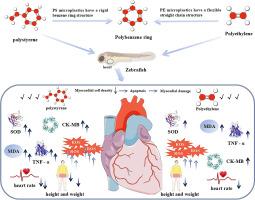聚苯乙烯和聚乙烯微塑料对斑马鱼心血管系统的毒性作用及其差异机制。
IF 4.3
3区 环境科学与生态学
Q2 BIOCHEMISTRY & MOLECULAR BIOLOGY
Comparative Biochemistry and Physiology C-toxicology & Pharmacology
Pub Date : 2025-09-12
DOI:10.1016/j.cbpc.2025.110353
引用次数: 0
摘要
本研究探讨了聚苯乙烯(PS)和聚乙烯(PE)微塑料对斑马鱼心血管系统的毒性作用及其机制的差异。以斑马鱼(Danio rerio)幼体为研究对象,通过生理参数测量、组织病理学分析和分子生物学技术,系统评价了两种微塑料对斑马鱼生长发育、氧化应激、心肌细胞数量和结构、组织病理学改变、细胞凋亡和基因表达的影响。实验结果表明,PS对体重的抑制作用更为显著,而PE对体长的抑制作用更为显著。两种物质均引起剂量依赖性心率降低,诱导氧化应激,加重心肌损伤和纤维化,并激活炎症反应。此外,PS和PE微塑料在毒性机制上也存在差异。PS增强毒性主要是通过其刚性苯环结构的吸附能力。而PE由于其较强的疏水性,更容易在心肌组织中积累,通过物理损伤途径加剧细胞凋亡。本研究首次比较了PS和PE微塑料对斑马鱼心血管毒性的差异机制,为微塑料相关的环境风险评估和人类健康保护提供科学依据。本文章由计算机程序翻译,如有差异,请以英文原文为准。

Toxic effects of polystyrene and polyethylene microplastics on the zebrafish cardiovascular system and their differential mechanisms
This study investigated the toxic effects of polystyrene (PS) and polyethylene (PE) microplastics on the cardiovascular systems of zebrafish, as well as the differences in their mechanisms. Using a larval zebrafish (Danio rerio) model, we systematically evaluate the effects of the two microplastics on growth and development, oxidative stress, myocardial cell number and structure, histopathological changes, cell apoptosis, and gene expression via physiological parameter measurements, histopathological analysis, and molecular biological techniques. The experimental results showed that PS exerted a more significant inhibitory effect on body weight, whereas PE had a more marked inhibitory effect on body length. Both substances caused a dose-dependent decrease in heart rate, induced oxidative stress, aggravated myocardial damage and fibrosis and activated inflammatory responses. Additionally, PS and PE microplastics exhibit differences in their toxic mechanisms. PS enhances toxicity primarily through the adsorption capacity of its rigid benzene ring structures. While PE, due to its strong hydrophobicity, tends to accumulate more readily in myocardial tissue and exacerbate cell apoptosis via physical damage pathways. This study is the first to compare the differential mechanisms of cardiovascular toxicity between PS and PE microplastics in zebrafish, providing scientific evidence for environmental risk assessment and human health protection related to microplastics.
求助全文
通过发布文献求助,成功后即可免费获取论文全文。
去求助
来源期刊
CiteScore
7.50
自引率
5.10%
发文量
206
审稿时长
30 days
期刊介绍:
Part C: Toxicology and Pharmacology. This journal is concerned with chemical and drug action at different levels of organization, biotransformation of xenobiotics, mechanisms of toxicity, including reactive oxygen species and carcinogenesis, endocrine disruptors, natural products chemistry, and signal transduction with a molecular approach to these fields.

 求助内容:
求助内容: 应助结果提醒方式:
应助结果提醒方式:


